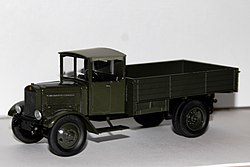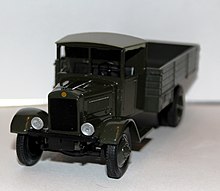Yes-4 (truck)
| ЯГАЗ | |
|---|---|
|
Model of a Ja-4
|
|
| Yes-4 | |
| Manufacturer: | Ярославский государственный автомобильный завод |
| Sales designation: | Я-4 |
| Production period: | 1928-1929 |
| Previous model: | Yes 3 |
| Successor: | Yes-5 |
| Technical specifications | |
| Designs: | Cot |
| Engines: | Gasoline engine |
| Power: | 51.5 kW |
| Payload: | 4 t |
| Perm. Total weight: | 8.7 t |
The Ja-4 ( Russian Я-4 ) was a two-axle truck made by the Soviet manufacturer Jaroslawski Gossudarstwenny Avtomobilny Sawod (short JaGAZ, Russian ЯГАЗ). It replaced the Ja-3 and was produced in series from 1928 to 1929, with around 140 copies being built. The vehicle was the first Soviet-made truck that was able to carry four tons of payload. Probably none of them have survived today.
Vehicle history
The first truck built in Yaroslavl since 1925, the Ja-3 , had a major problem: with 35 hp and a total weight of 7.2 tons, it was severely underpowered. As a result, the maximum speed had to be structurally limited to 25 km / h and the payload to three tons, although the vehicle could have been loaded with five tons. In the 1920s, there was no suitable engine with the corresponding power from Soviet production.
In order to improve the driving behavior of the trucks anyway, engines were ordered from Daimler-Benz from Germany in 1928 . It was the type M 26 , an in-line six-cylinder gasoline engine that was also installed in the Mercedes-Benz L 2 . It made 70 hp and thus twice as much as the previously installed engine from the AMO-F-15 . Depending on the information, 137 or around 180 engines were procured. Bosch delivered a brake booster as a further novelty, as the truck with a gross vehicle weight of almost nine tons was far too heavy for purely mechanical brakes without reinforcement. In the course of 1928, however, there was a departure from the German automotive industry and more intensive cooperation with American companies shaped the following decades.
The body and the cab have been redesigned. In particular, the significantly larger Mercedes engine had to find space under the hood. Most of the pre-war trucks from Yaroslavl retained the design. In addition, the side walls have been redesigned. The small window behind the B-pillar was omitted, instead the side walls were made of tarpaulin with celluloid windows. The roof was also covered with a tarpaulin, later models such as the successor Ja-5 received a solid roof again. The side tarpaulins could be opened when the weather was nice. The bumper does not extend over the entire width of the front. For the first time in Soviet truck construction, stable tow hooks were attached. A starter was also installed.
The number of vehicles built has not been conclusively clarified. In the literature it is stated that 28 vehicles were built in 1928 and another 109 vehicles in 1929. Other sources speak of around 180 purchased engines and deduce a corresponding number of trucks from this. In early documents, the specification of 54 hp for the engine power is sometimes found different.
The trucks were mainly used in large cities. In the Soviet Union in the 1920s, there were few roads and mostly bridges in the countryside that would have been suitable for a heavy truck like the Ja-4. In the fall and spring, most roads became temporarily impassable due to mud. Some of the trucks went to the Red Army and were used there to pull heavy artillery. In addition, some were probably used in the 1930s for the movement of goods on the Chuiski tract from Siberia via the Altai Mountains to Mongolia . There is no evidence that a Ja-4 has survived to this day.
Since there was no spare parts supply for the engines, domestic engines from the AMO-3 or the ZIS-5 were later installed in the event of serious damage . For general repairs and similar occasions, parts from the successor Ja-5, which was produced in larger numbers, were often installed later.
Technical specifications
For the Ja-4, as far as known.
- Engine: in-line six-cylinder petrol engine
- Engine type: Mercedes-Benz M 26
- Power: 70 PS (51.5 kW)
- Displacement: 7069 cm³
- Bore: 100 mm
- Stroke: 150 mm
- Tank capacity: 120 l
- Transmission: mechanical manual transmission, 4 forward gears
- Top speed: 45 km / h
- Brake booster from Bosch-Devaunder
- Drive formula : 4 × 2
Dimensions and weights
- Length: 6635 mm
- Width: 2460 mm
- Height: 2550 mm
- Wheelbase: 4200 mm
- Front track: 1750 mm
- Rear track: 1784 mm
- Empty weight: 4700 kg, according to other sources also up to 4900 kg
- Payload: 3.5–4 t
- permissible total weight: 8.7 t
- Tire size: 40 × 8 "
Individual evidence
- ↑ a b c d e f g 80 лет ярославской «четырёхтонке». Грузовик Я-4 1928 г. (Russian)
- ↑ Дмитрий Дашко: Советские грузовики 1919-1945. Moscow 2014, without ISBN, p. 35. Partly available online at Google Books.
- ↑ a b L. M. Shugurow: АВТОМОБИЛИ. России и СССР. First part. P. 63.
- ^ Werner Oswald : Mercedes-Benz trucks and buses. 1896-1986. Motorbuch, Stuttgart 2008, ISBN 978-3613029439 , p. 163.
literature
- LM Shugurov: АВТОМОБИЛИ. России и СССР. First part. Ilbi / Prostreks, Moscow 1993, ISBN 5-87483-004-9 .
Web links
- 80 лет ярославской «четырёхтонке». Грузовик Я-4 1928 г. Journal article on Ja-4. (Russian)
- Yes-4 website including historical photographs (Russian)
- Manufacturer website with factory history (Russian)




